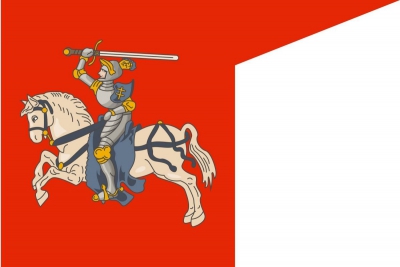The Battle of Karuse or Battle on the Ice was fought on 16 February 1270 between the Grand Duchy of Lithuania and the Livonian Order on the frozen Baltic Sea between the island of Muhu and the mainland. The Lithuanians achieved a decisive victory. The battle, named after the village of Karuse, was the fifth-largest defeat of the Livonian or Teutonic Orders in the 13th century. Almost all that is known about the battle comes from the Livonian Rhymed Chronicle, which devoted 192 lines to the battle.
The Grand Duchy of Lithuania was a European state that lasted from the 13th century to 1795, when the territory was partitioned among the Russian Empire, the Kingdom of Prussia, and the Habsburg Empire of Austria. The state was founded by Lithuanians, who were at the time a polytheistic nation born from several united Baltic tribes from Aukštaitija.The Grand Duchy expanded to include large portions of the former Kievan Rus' and other neighbouring states, including what is now Lithuania, Belarus and parts of Ukraine, Latvia, Poland, Russia and Moldova. At its greatest extent, in the 15th century, it was the largest state in Europe. It was a multi-ethnic and multi-confessional state, with great diversity in languages, religion, and cultural heritage.
The consolidation of the Lithuanian lands began in the late 12th century. Mindaugas, the first ruler of the Grand Duchy, was crowned as Catholic King of Lithuania in 1253. The pagan state was targeted in the religious crusade by the Teutonic Knights and the Livonian Order. The rapid territorial expansion started at the late reign of Gediminas and continued to expand under the diarchy and co-leadership of his sons Algirdas and Kęstutis. Algirdas's son Jogaila signed the Union of Krewo in 1386, bringing two major changes in the history of the Grand Duchy of Lithuania: conversion to Christianity and establishment of a dynastic union between the Grand Duchy of Lithuania and the Crown of the Kingdom of Poland.The reign of Vytautas the Great, son of Kęstutis, marked both the greatest territorial expansion of the Grand Duchy and the defeat of the Teutonic Knights in the Battle of Grunwald in 1410. It also marked the rise of the Lithuanian nobility. After Vytautas's death, Lithuania's relationship with the Kingdom of Poland greatly deteriorated. Lithuanian noblemen, including the Radvila family, attempted to break the personal union with Poland. However, unsuccessful wars with the Grand Duchy of Moscow forced the union to remain intact.Eventually, the Union of Lublin of 1569 created a new state, the Polish–Lithuanian Commonwealth. In the Federation, the Grand Duchy of Lithuania maintained its political distinctiveness and had separate ministries, laws, army, and treasury. The federation was terminated by the passing of the Constitution of 3 May 1791, when it was supposed to become a single country, the Commonwealth of Poland, under one monarch, one parliament and no Lithuanian autonomy. Shortly afterward, the unitary character of the state was confirmed by adopting the Reciprocal Guarantee of Two Nations.
However, the newly reformed Commonwealth was invaded by Russia in 1792 and partitioned between neighbouring states. A truncated state (whose principal cities were Kraków, Warsaw and Vilnius) remained that was nominally independent. After the Kościuszko Uprising, the territory was completely partitioned among the Russian Empire, the Kingdom of Prussia and Austria in 1795.

 English
English  español
español  français
français  português
português  русский
русский  العربية
العربية  简体中文
简体中文 
